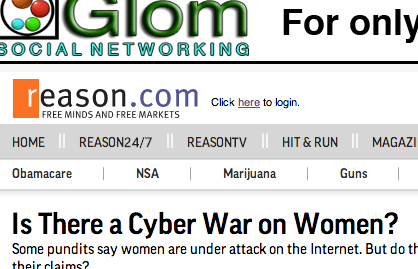In Response To Cathy Young
By Saul Burton

Last week, Cathy Young published an article on Reason, ‘Is There a Cyber War on Women?’. Her piece is a response to Amanda Hess’ Pacific Standard article, ‘Why Aren’t Women Welcome on the Internet?’, in which Hess describes her own experience of being threatened and stalked online.
Hess argues that there exists a persistent culture of misogyny online, and that this culture has meaningfully discouraged women’s presence on the internet.
Young’s first response is to elaborate on, and correct, some of the statistics Hess employs. Debates rarely suffer from the infusion of more information, and by taking a closer look at the studies Hess cites, Young adds something of value to the debate.
Young acknowledges, almost in passing, that women and men are exposed to different sexual risk, and come with different historical baggage:
This double standard is based partly on women’s greater sexual vulnerability (specifically, the risk of sexual violence) and partly on historical inequities. Because journalism and political discourse were traditionally men’s territory, a slur that targets a woman’s gender or sexuality is taken to attack her as an interloper. A below-the-belt insult directed at a male writer is just an insult.
She then goes on at length about feminism’s own contributions to hateful speech before concluding:
To demand special protection on the grounds of women’s particular vulnerabilities is to turn female disempowerment into a self-fulfilling prophecy. When we casually assume that a woman suffers more harm from a nasty (or even sexually threatening) online comment than a man does from, say, castration threats and gibes about pedophilia or jeers about the death of his infant child, we’re not only being callous to men, but upholding the very stereotypes of “the weaker sex” that feminists supposedly deplore.
There is faulty logic at work here.
First, there is a substantive and meaningful difference between nasty comments and threats of violence, sexual or otherwise, and this line is blurred in both articles. Hess herself lists them both in the same parenthetical aside:
But when anonymous harassers come along – saying they would like to rape us, or cut off our heads, or scrutinize our bodies in public, or shame us for our sexual habits – they serve to remind us in ways big and small that we can’t be at ease online.
Being called a slut and being threatened are not equivalent events; however, both authors suggest that they are. Hess treats rudenesses and threats as though they exist along a spectrum, and stem from a single cause: hatred of women. Young counters that men also experience vitriolic attack on the internet; while that is true, she then implies that women would do better to treat threats the way men do, to consider the invective “as deplorably crass but not particularly injurious.”
It is all well and good to declare that vitriolic abuse come with the Internet territory, and that women need to grow a thicker skin about what are largely mere insults; however, Young’s advice, to ignore all but the real threats, does not take into account that it is difficult to tell which threats might be real, or that women are trained to take all rape threats seriously.
Women are socialized to be vigilant against rape in their adult lives. When they go to parties, they must watch their drinks. When they meet blind dates, they are advised to tell a friend their whereabouts. When they walk alone at night, they track the men walking behind them. When their vigilance fails, or, more importantly, fails to protect them, they are often blamed for insufficient caution.
This necessarily increased awareness of vulnerability means that rape threats have a terrorizing effect on women that they do not have on men, or, at least, not to the same degree. Men are victims of sexual violence; however, they are not conditioned to fear it in the same way, nor as they as likely to be victims of it. Despite Young’s assertion, acknowledging the different likelihoods that a rape threat represents to a woman versus a man is not infantilizing women. Reality is not patronizing.
This is not to say that women are more vulnerable as a gender; in fact, in the United States, men are much more likely to be victims of murder than women. However, women are overwhelming more vulnerable to sex crimes. We treat sexual violence differently than non-sexual violence for good reasons: it often stems from different causes, may arise in different situations, and it has different effects on its victims, men or women. The fact that women are more likely to be victims of this kind of violence does not make them weaker, just as the fact that men are more likely to be perpetrators of this kind of violence does not make them evil.
This differential in effect is important not because women need special care and handling; rather, it is because the law surrounding protections of speech versus criminality of threat center in large part on the effect of the threat on the victim. In many states in the U.S., assault laws proscribe speech that creates reasonable fear of harm in a victim. Other statutes specify that victims of threatening speech would need to reasonably fear that the speaker had the means and motive to carry their threat out. In this case, women would be more likely than men to believe threats of sexual assault.
A background of gendered hostility, while not itself criminal, informs that fear in women. If a woman knows that the internet is home a great deal of real, active misogyny – if, for example, she had ever stumbled across Reddit’s famous “chokeabitch”, “beatingwomen”, “rapebait”, or “niggerjailbait” subreddits – then she might be excused for worrying that the world is overrun with extremely angry, potentially dangerous men.
However, to say that a hostile internet culture informs fear is not to say that it encourages violence. While a volley of anonymous abuse might make the world seem more dangerous, it does not necessarily make the world become more dangerous. In the United States, violent threats are illegal, but illegal speech is the exception. Offensive or prejudiced speech is still protected speech, and we tamper with free speech at our own risk. Hess advocates treating online threats as hate-crimes – that would be a mistake. It is enough for threats simply to be crimes, if the laws against them are enforced.
Hess’ own experience makes it clear that anti-harassment laws are not finding traction on the internet. This is in part because we still treat the web as a separate space. We need to stop pretending that the real world ends where the internet begins. We meet, shop, work, and celebrate online. Speech on the internet is not less real than speech anywhere else, and when an individual has been taught to fear violence, a threat on the internet forms a continuum with the threats they perceive in life.
This is what Hess means when she writes:
I’ve been threatened online, but I have also been harassed on the street, groped on the subway, followed home from the 7-Eleven, pinned down on a bed by a drunken boyfriend, and raped on a date. Even if I sign off Twitter, a threat could still be waiting on my doorstep.
Young proposes that men are equally likely to be the recipients of abusive speech; that may well be true. Men are menaced with violence on the internet and in life, and there are certainly threats that would upset a man as much as a rape threat might frighten a woman. Ideally, however, this conversation shouldn’t be a game of misery poker.
No one, male or female, has the right not to have their feelings hurt, even their very tender, historically-aggrieved feelings. Young makes a number of good points about double standards of speech in the feminist movement; nevertheless, she comes dangerously close to blaming rude feminists for misogyny: “Internet feminists have played a major role in turning online discussion of gender issues into a toxic swamp that naturally attracts trolls.” This may have import in a discussion of online civility – it is irrelevant in the context of threatening speech or behavior. Feminists who censure either women or men for non-orthodoxy are repellent. Misogynists are bigots. In matters of speech, bigots are ugly, but this doesn’t make them criminals. People who make threats of violence, men or women, are committing a crime, and that distinction is worth observing. ![]()




